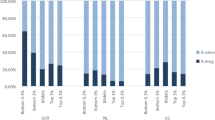Abstract
The Medicare Modernization Act of 2003 added a new outpatient prescription drug benefit to Medicare and increased payments to HMOs. We estimate a nested logit model of plan choice to quantify the welfare benefits from these two expansion paths. We find that the addition of stand-alone prescription drug plans was welfare improving and produced nine times as much value per government dollar as the increase in payments to HMOs. In light of these results, we suggest that HMO bidding procedures should be modified to reduce payments to HMOs by about $67 billion over the next 10 years.
Similar content being viewed by others
References
Atherly A. (2002) The effect of Medicare supplemental insurance on Medicare expenditures. International Journal of Health Care Finance and Economics 2: 137–162 doi:10.1023/A:1019978531869
Atherly A., Dowd B.E., Feldman R. (2004) The effect of benefits, premiums, and health risk on health plan choice in the Medicare program. Health Services Research 39(4, Part I): 847–864
Berenson R. (2004) Medicare disadvantaged and the search for the elusive ‘level playing field’ Health Affairs Web Exclusive 15: W4-572–585
Berry S., Levinsohn J., Pakes A. (1995) Automobile Prices in Market Equilibrium. Econometrica 63(4): 841–890 doi:10.2307/2171802
Cawley J., Chernew M., McLaughlin C. (2005) HMO participation in Medicare managed care. Journal of Economics & Management Strategy 14(3): 543–574 doi:10.1111/j.1530-9134.2005.00073.x
Cutler D., Sheiner L. (2000) Generational aspects of Medicare. The American Economic Review 90(2): 303–307
Feldman R. (1994) The welfare economics of a health plan merger. Journal of Regulatory Economics 6(1): 67–86 doi:10.1007/BF01065391
Frakt A.B., Pizer S.D. (2006) A first look at the new Medicare prescription drug plans. Health Affairs Web Exclusive 25: w252–w261
Greene W.H. (2003) Econometric analysis. Prentice Hall, Upper Saddle River New Jersey
H. J. Kaiser Family Foundation. (2004). Prescription drug coverage for Medicare beneficiaries: an overview of the Medicare prescription drug, improvement, and modernization act of 2003 (Public Law 108–173), 14 January 2004, http://www.kff.org/medicare/6120.cfm (8 August 2005).
H. J. Kaiser Family Foundation. (2005). Prospects for retiree health benefits as Medicare prescription drug coverage begins: Findings from the Kaiser/Hewitt 2005 survey on retiree health benefits, December 2005, http://www.kff.org/medicare/7439.cfm..
Jack W., Sheiner L. (1997) Welfare-improving health expenditure subsidies. The American Economic Review 87(1): 206–221
Jindal, B. P. (2002). Assistant Secretary for Planning and Evaluation, Department of Health and Human Services, Testimony before the Subcommittee on Health of the House Committee on Energy and Commerce, Hearing on Medicare Modernization: Examining the Federal Employees Health Benefit Program as a Model for Seniors, March 20, 2002.
Maddala G.S. (1983) Limited dependent and qualitative variables in econometrics. Cambridge University Press, Cambridge
MCBS home page: http://www.cms.hhs.gov/MCBS/default.asp..
McFadden, D. (1974). Conditional logit analysis of qualitative choice behavior. In P. Zarembka (Ed.), Frontiers in econometrics. New York: Academic Press (pp. 105–142).
Medicare Payment Advisory Commission (MedPAC). (2007). Report to the Congress: Medicare Payment Policy, March 2007.
Mello M.M. et al (2003) Understanding biased selection in Medicare HMOs. Health Services Research 38(3): 961–992
Nevo A. (2001) Measuring market power in the ready-to-eat cereal industry. Econometrica 69(2): 307–342
Pauly, M. V., & Zeng, Y. (2003). Adverse selection and the challenges to stand-alone prescription drug insurance, NBER Working Paper No. W9919.
Pizer, S. D., Feldman, R., & Frakt, A. B. (2005). Defective design: Regional competition in Medicare. Health Affairs Web Exclusive, 24, W5-399-411.
Pizer S.D., Frakt A.B. (2002) Payment policy and competition in the Medicare + Choice program. Health Care Financing Review 24(1): 83–94
Pizer S.D., Frakt A.B., Feldman R. (2003) Payment policy and inefficient benefits in the Medicare + Choice program. International Journal of Healthcare Finance and Economics 3(2): 79–93
Pizer S.D., Frakt A. B., Feldman R. (2008) Predicting risk selection following major changes in Medicare. Health Economics 17(4): 453–468
Small K.A., Rosen H.S. (1981) Applied welfare economics with discrete choice models. Econometrica 49(1): 105–130
Town R., Liu S. (2003) The welfare impact of Medicare HMOs. Rand Journal of Economics 34(4): 719–736
Trajtenberg M. (1989) The welfare analysis of product innovations, with an application to computed tomography scanners. Journal of Political Economy 97(2): 444–479
Author information
Authors and Affiliations
Corresponding author
Rights and permissions
About this article
Cite this article
Pizer, S.D., Frakt, A.B. & Feldman, R. Nothing for something? Estimating cost and value for beneficiaries from recent medicare spending increases on HMO payments and drug benefits. Int J Health Care Finance Econ 9, 59–81 (2009). https://doi.org/10.1007/s10754-008-9047-x
Received:
Accepted:
Published:
Issue Date:
DOI: https://doi.org/10.1007/s10754-008-9047-x




